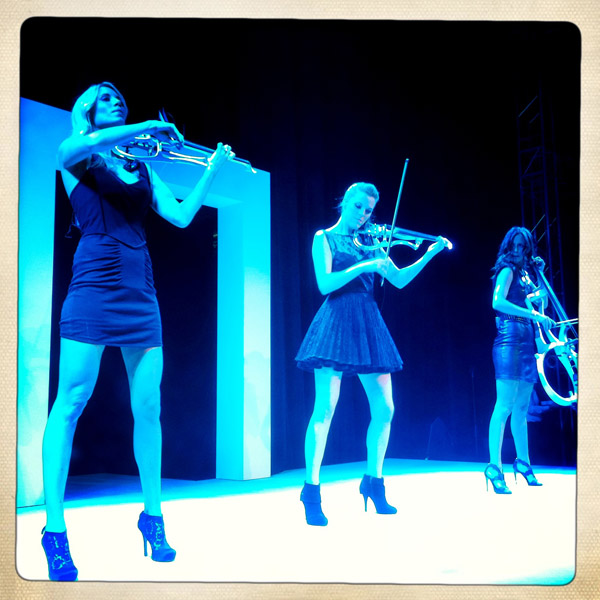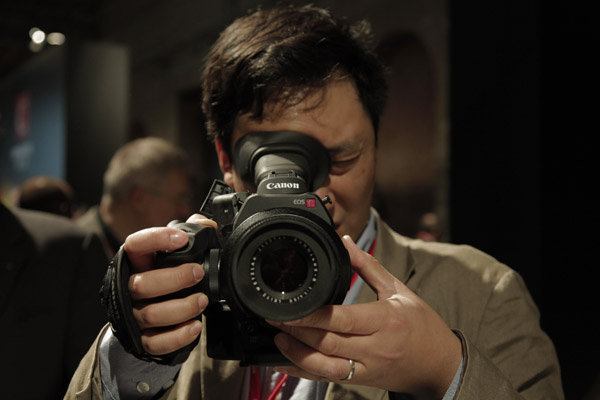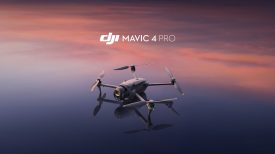By Dan Chung
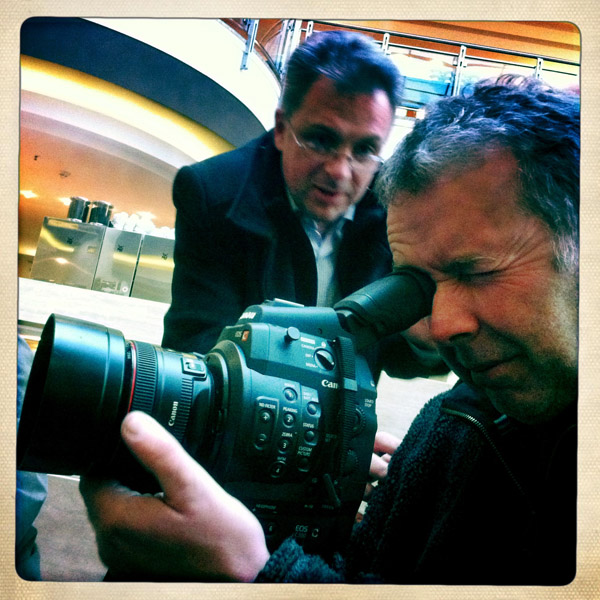
Two days ago I attended the European launch of the Canon C300 cameras in Berlin. It was aimed very much at the business end of our industry event with major TV broadcasters, dealers, rental houses and some key DOPs in attendance.
Canon chose the event to emphasize their commitment to being a part of the film and TV industry. Ryoichi Bamba, President and CEO of Canon Europe, Middle East and Africa was very keen to make it clear that they are listening to what people are saying and that the C300 is just the start of what he hoped to be a long relationship. To make this point Bamba quoted from Al Jolson in the Jazz Singer – the first ever Hollywood talkie – saying “You ain’t heard nothin’ yet”. Canon are clearly in it for the long haul.
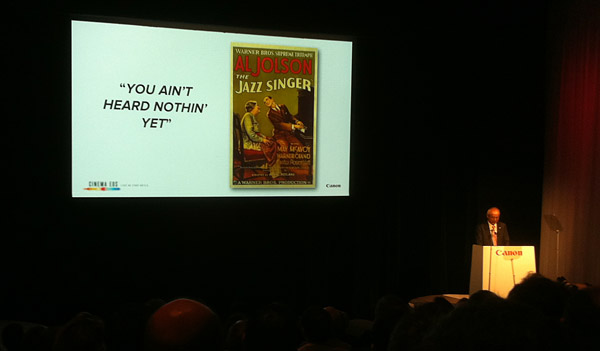
Let me say from the start of this blog post that from now onwards I am talking about this camera in terms of it’s suitability for current affairs, factual and documentary work. I am not going to attempt to compare it to the Red Scarlet, Epic or Arri Alexa as a Hollywood or indie movie camera. That is for others better qualified than me to discuss elsewhere.
The camera price has still not been officially announced but prices in the region of 12,000 to 13,000 Euro are being talked of by dealers. This is lower than the $20K price mentioned at the US launch, although if true sales taxes will probably mean $20K may still be the price you pay in Europe. Canon would not give an official price at the event and I really hope that the street price is much lower.

Spiritually the C300 is an EOS, you only have to look at next to the 5DmkII to see that it shares the same basic design but in a bigger shell. It looks and feels like a old medium format SLR camera. I personally love the design and the camera was very comfortable to hold in my hands. I was pleasantly surprised to get pretty good handheld shots with just the C300 and image stabilised lens but no support rig. That said I’d like to see a future version with shoulder mounted shooting more in mind (much in the same way that Sony offer similar specified cameras in slightly different configs) – rigs are great but a camera that works on the shoulder straight off is better.
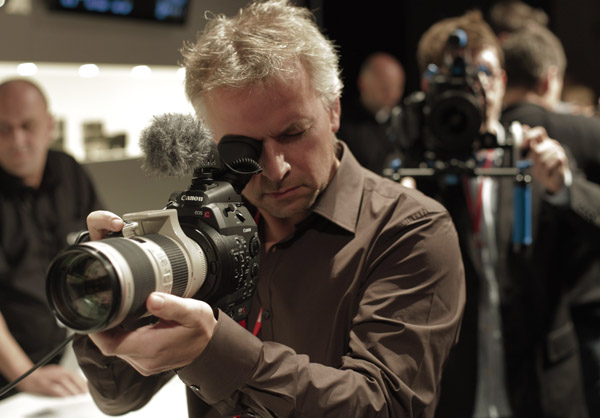
Canon have kept the body weight down and it’s not much heavier than a pro DSLR body like the EOS-1D X. For me this is critically important – it means I can use the camera in the way I did the 5D mkII before it – as part of my one man band backpack shoot kit. Pretty much all my support and stabilization gear was bought to work with DSLR and Sony EX1 cameras. With the C300 I would be fine using my existing tripod, Pocketdolly, Steadicam, Jib arm, car suction mounts, Shoulder rig etc… (assuming I use stills lenses not the heavier Cine ones). The cost of replacing gear to handle a heavier camera like the Scarlet or Sony F3/external recorder is substantial.
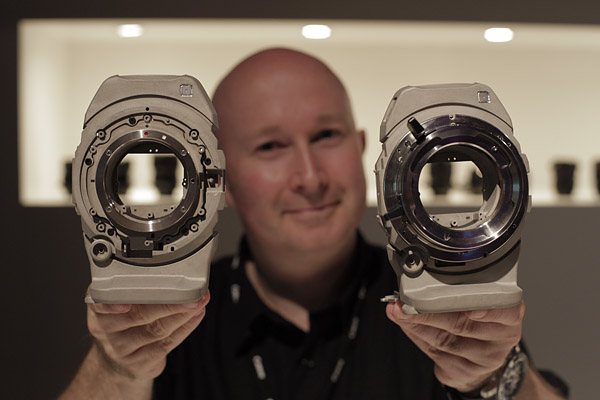
The camera comes in two versions – PL and EOS mount. I could live with just EOS mount lenses but would much rather it had been an interchangeable EOS/PL mount so you could use a wider range on lenses on the same body. Canon engineers said their needed to be two version to guarantee structural strength with heavy lenses.
The Electronic viewfinder (EVF) in the camera body is great – no real need for an external third party EVF in many cases. It was very easy to see and I felt judging focus was easier on this than competing cameras (I never use the one on the Sony F3). The only thing that I missed was the 10x magnify function of DSLRs when checking precise focus. The C300’s EVF only seems to show actual pixels magnification as I suppose the sensor is not capable of creating the 10x view. The good news is that this magnification can be done when shooting, unlike DSLRs which can only do this before you roll.
Battery life is great, a single BP955 battery is perfect for shooting long stretches. Much better than a DSLR. The custom keys are also great and allow rapid access to many of the camera’s functions with a single button press.
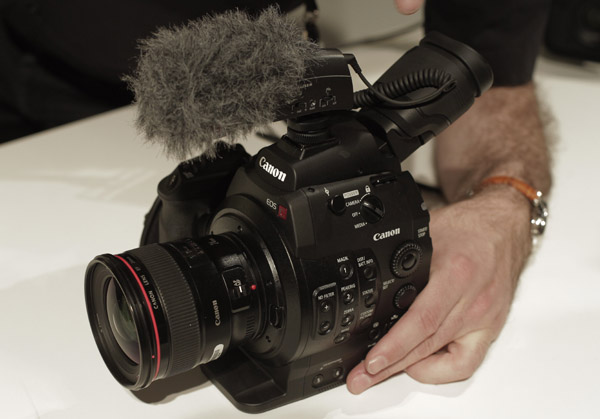
Audio is handled by the bolt on XLR/LCD screen module that comes with the camera – personally I’d rather have had all the XLR connections in the body itself. The response Canon gave me was that cinema shooters had said they preferred a smaller body to XLR in camera. There is however a minijack on the C300 which can have audio controlled pretty much the same way as the 5DmkII but with heaphone monitoring. Using some of the lessons learned using minijack gear with DSLR I think I’d be more comfortable running around with a simple top mic or radio mic in many situations simply to avoid having the bulk of the Monitor/audio pack on top of the camera.
Canon have designed the sensor from scratch and it’s not a modified stills sensor. By doing that they were able to optimize it fully for video at every stage. It is a 8.3 megapixel sensor but instead of recording 5K it records 1080P by using the pixels in groups of four (2 green, 1 blue, 1 red) to better achieve better colour sampling like a RGB sensor in a 3 CCD camcorder. This sensor delivers a claimed 1000+ TV lines of resolution with absolutely no trace of moire and little rolling shutter. It has a base sensitivity of ISO 850.
One disappointment for me was to see 50P and 60P frames only supported at 720P and not the full 1080P resolution. For slow motion work this may be a deal breaker for some.
Being Super35 not ‘full frame’ like the 5D mkII or 1D X does mean that it trades a bit of that shallow depth of field magic for the more conventional cinema look. It’s roughly the same size sensor as the 7D or 600D/T3i cameras.
The sensor clearly has excellent dynamic range and Canon claims 12 stops of latitude. That said the competing Sony F3 claims similar if not better range (13.5 stops with S-Log upgrade) and Sony FS100 is not far behind. Figures are not everything and what matters is what this looks like in the final image. It will be interesting to see what the images look like when compared.
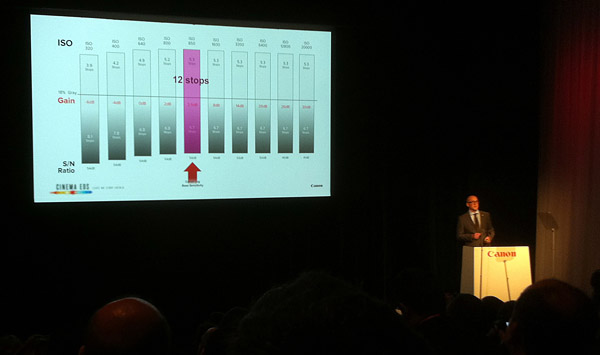
What is nice is that the Canon Log gamma is included with the camera (not extra like Sony) although for a lot of my fast turnaround work I would rather use a regular gamma as there is little time to grade. For that their are also 2 non-log Cine gammas which match those on the XF105 and XF305 camcorders and I assume that these will cut together well. There is also an EOS standard gamma like that of the 5D mkII.
The C300‘s aperture control with EOS lenses is on the left side of the camera and not on a rear control dial like the 5D mkII. At first I found this a little confusing and I’d have preferred the option to adjust aperture one handed like Canon DSLRs. Talking of aperture control the camera can control EF lenses in 1/3 stops increments as with the 5D mkII (EDIT – Canon sources have corrected me saying on the C300 there is also a ‘fine’ aperture step, something like 7,8 or 9 increments between f-stops). It is sadly not stepless and this seems to be a limitation of the lenses.
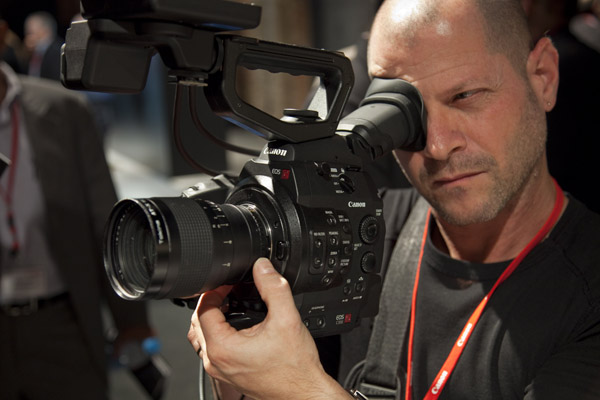
I tested a couple of old manual lenses – an adapted Leica R lens and a ISCO anamorphic with Nikon mount adapted. Both worked just fine and I don’t see a problem using older third party lenses with this camera.
In terms of image quality we were allowed to see the image from the camera on large monitors but not record anything ourselves. What I saw seemed to verify Canon’s claims of near 1000 TV lines of resolution. They also had a low light area where we could see for ourselves the low noise and excellent colour saturation in a very dark scene.
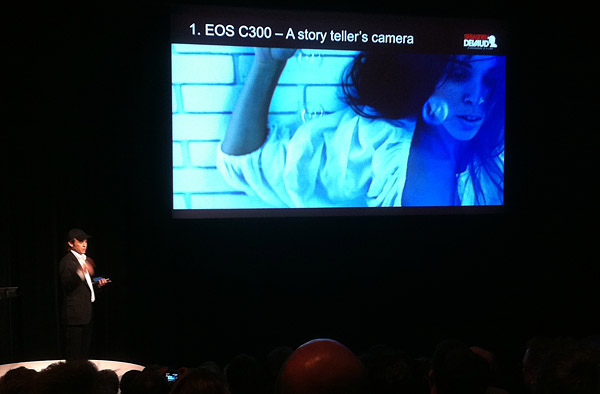
Canon showed a couple of the films from the Hollywood launch as well as an impressive short film commissioned from French filmmaker Sebastien Devaud. I was really impressed with the projected image quality on the big screen, especially of Vincent Laforet’s Mobius. It looked incredibly film like and I would be very happy if my footage resembled that technical quality – Vincent tell’s me he and his DP Polly Morgan used Canon Log gamma and good exposure to achieve this. Other footage shown at the event did look more video like to me and I would really like to test the camera myself in different lighting conditions to see what’s possible.
Mobius – 1080p HQ from Vincent Laforet on Vimeo.
The internal recording is 8 Bit 4:2:2 MPEG-2 Long GOP at a max bitrate of 50Mbps. None of the other cameras in it’s class can do this internally and it’s better than Sony’s F3 or FS100. Importantly this camera it likely to meet BBC HD approval standards with ease – Alan Roberts who writes their reports was at the event and should be evaluating it soon. To get this same bitrate with the Sony F3 or FS100 you need dangling cables and an external recorder like the Nanoflash or KiPro Mini.
Better still the C300 records to regular fast Compact Flash (CF) cards and can record to 2 simultaneously for backup. The choice of CF cards makes shooting for extended periods without a laptop or power a possibility. Should I ever have to cover something as terrible as the Iraq war again I would certainly benefit from using lots of CF cards instead of having to dump footage all the time.
Images are recorded using the MXF file format which is perfect for docu, news and other rapid turnaround TV productions – many shooters wanted to see the C300 have RAW files like the Reds and in some fields I think that is a legitimate request. But for fast turnaround or shoots where there are hours of material MXF MPEG-2 format is perfect. It can drop straight into most editing software timelines with no transcode at all. It’s also used by Canon’s XF305 and 105 camcorders and editing these alongside a C300 should be a breeze.
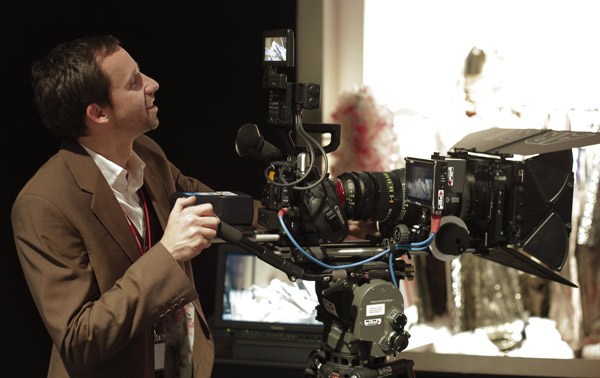
One thing that many pros have cited as being a negative is that the C300 only captures 8 bit images. Also the C300 is 8 bit all the way through from the sensor so don’t look for a 10 bit firmware fix anytime. That said the sensor combined with 8 bits seems very capable. Canon sources have argued that you are better off with a more perfect original image recorded in 8 bit, than one from a lesser sensor at 10 bit. What I can say is that the images Canon were showing are plenty good enough for any of my current clients and any news, docu or current affairs program I can think of.
Would I have preferred to have the option to record RAW or 10bit to an external recorder? most certainly and I think Canon missed a trick here. Given their ‘You ain’t seen nothing yet’ statement I’m sure that means these things are coming down the line. This is a double edged sword – it reassures us that Canon is serious about creating better cameras, but if I were to buy the C300 I would prefer not be jealously eyeing up a better sister camera in 12 months time. I remember all too well my pain at seeing the Sony EX3 with it’s interchangeable lens come along shortly after I had got an EX1.

For now I think lenses are the most serious issue Canon has to address for documentary, news and run and gun shooting with this camera. There is no ‘proper’ run and gun lens to match this camera and it’s sensor. The closest Canon gets is the 17-55 f2.8 EF-S lens and that has a pretty bad manual focus ring – certainly not befitting of a camera like the C300. The better built L zoom lenses like the 16-35mm f2.8L and 24-105mm f4L are just too short range or not wide enough for a one lens solution on the Super35mm sensor size. The Cine lenses launched with the camera are wonderful but high priced and their 300 odd degrees of rotation pretty much rule them out for handheld run and gun work.
Sony has the 18-252mm servo zoom lens for it’s F3 so that’s an advantage over Canon (at a price). Like many others my ideal lens would be an f2.8 of f3.5 version of the existing Canon 15-85mm EF-S lens but with better construction and proper manual focus and image stabilizing – lets hope it comes in time.
The C300 price also effects lens choice in another way. To prevent having to change lenses and lose shots I currently to use two 5D mkII bodies at the same time with different lenses on each when shooting – just as I did as a stills shooter. That way I don’t have to swap lenses in dusty conditions and miss fewer shots swapping between wide and long lenses. Now you could of course do this with two C300 cameras but the cost would be way to high for me and most others. You could use a 1D X or a camcorder like the XF305 as a second ‘long lens’ camera instead but it would still add a lot to the cost and by the time you add that to your bag then it’s going to be pretty heavy.
On paper the C300 is the closest thing to being my perfect daily use, shallow depth of field video camera thus far announced – even if it was designed for Hollywood not documentary. It checks more of the boxes on my list than any other camera – although there is always room for improvement.
In reality I will need to test it in the field against it’s closest competitor the Sony PMW-F3, the Sony FS-100, the 1D X and the 5D mkII (or it’s replacement) to see which combo will find a regular place in my kit bag. Specs are fine but it’s handling and image quality that really count. What I can tell you now that it’s size and weight will weigh heavily in the C300’s favour when I come to deciding this.
All through the event I couldn’t help thinking that this camera is far less about Hollywood than it is about daily drama and factual TV production. I’m not sure how many will DOPs will choose the C300 over an Alexa, F65 or an Epic for high end motion picture work, but I can see it fitting right into the much bigger market for indie movies and TV series.
The price point means for many news and docu shooters it will remain a purely aspirational camera, or one that you might rent from time to time for specific assignments. But if your pockets (or that of your bosses) are deep enough then I recommend you take a close look at the C300 when it comes out in January.
